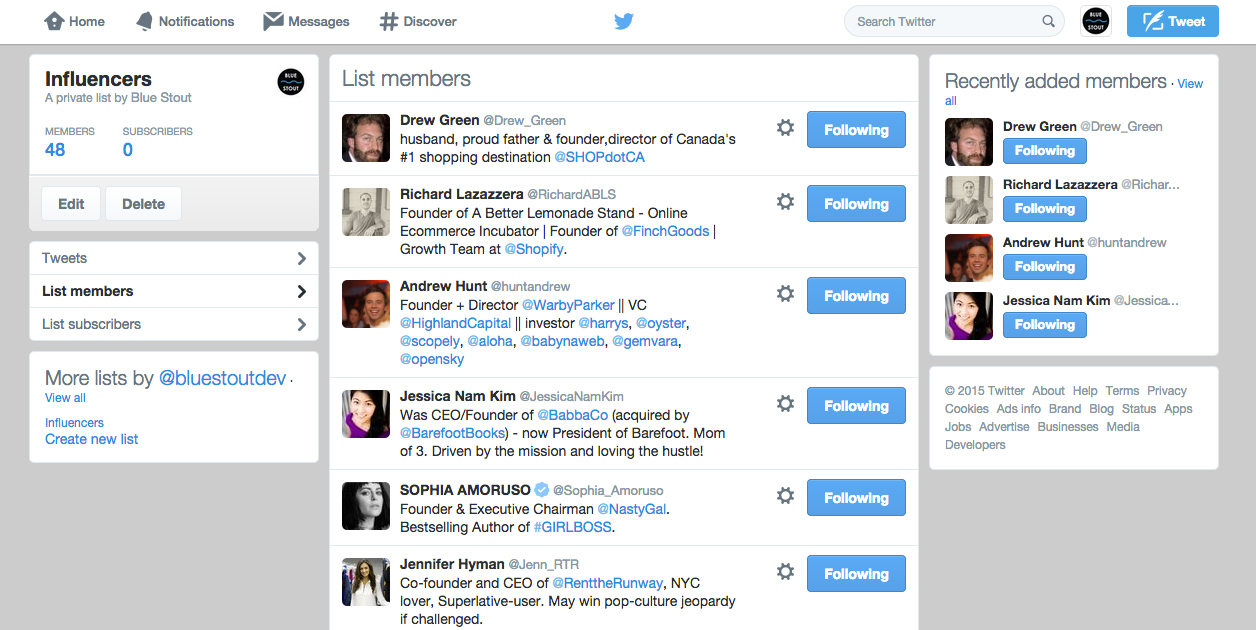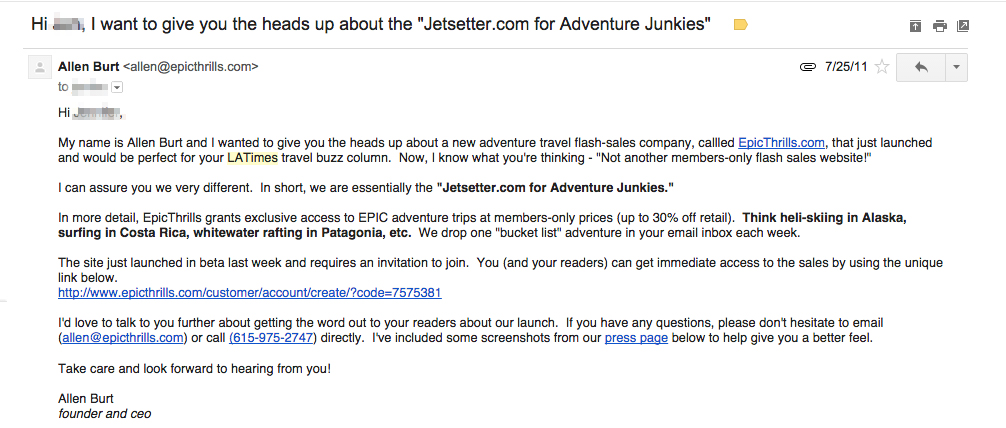How My Ecommerce Startup Got Featured In WIRED & the LA Times, and Acquired Our First Customers
When launching a new business, your first few customers are critical. It helps validate (or more commonly, disprove) early assumptions about your business, gives you real customer feedback, and hopefully drives some early revenue.
But, when you’ve just launched and nobody knows who you are, how do you go about getting those first 100 – or even 10 – customers?
At my first company, Offmap, we decided to leverage PR as our primary customer acquisition strategy. Within a few months, we were able to land articles in a handful of noteworthy publications. Those early mentions drove enough traffic to our landing page to sign up thousands of users and generate our first thousands in sales.
So, how did we do it?
Below, I’ll walk you through the process and tactics we used to land Offmap in WIRED and the LA Times (among others), generate our first few thousands in revenue, and boost our landing page sign-up rate by 30%.
1. Target the Right Publications
Most first time founders have a fascination with getting featured in tech publications like Techcrunch, PandoDaily, and Mashable. And, if your direct target market are tech nerds and startup founders, then this is a great place to aim your PR guns.
For the rest of us whose target demo isn’t as tech-obsessed, it’s a waste of time at best, and a detriment to your business at worst. A post on Techcrunch could send you thousands of new users who will interact with your product once and then never come back. Those users are not long-term, profit generating customers, and provide a false sense of progress.
At Offmap, we sold a revolutionary type of adventure travel package that combined digital guides on your phone with local outfitters in exotic destinations. This combination appealed to young, tech-savvy travelers. Why? Because we removed the annoying group tours and tour guides, and were able to sell our trips at prices 70% below normal retail.
To reach this target market, we needed features in publications that people had heard of to provide credibility (more on that below), and whose audience consisted of a large following of tech-savvy travelers.
The publications we targeted were:
- WIRED
- NY Times Travel
- LA Times Travel
- Gadling (An AOL travel blog at the time)
- Matador Network (A collection of adventure travel blogs)
- Huffington Post Travel
- Outside Magazine
Each of the above catered to our exact target market, travelers. And of the 7 publications targeted, 5 of them ending up publishing articles.
But remember: nobody knew us at this point! So, how did we convince 5 of 7 journalists to publish an article in a major publication about a company nobody had ever heard of?
2. Find Your Contact & Build A Relationship
The best time to build a relationship with a journalist is months before you pitch them a story.
Most journalist are very active on Twitter, and I would recommend creating a list of industry related journalists to begin following months leading up to your launch, or PR push. Create a list on Twitter, and make sure to actively engage with each person a few times a week. Share their Tweets, and respond to their stories with feedback and helpful commentary.

When the time comes, you’ll have a handful of connections that you can reach out to and share your story.
But, isn’t this just a form of glorious spamming, you ask? These journalist get pitched all of the time. Won’t they just ignore me?
No, not if you have a great story. In fact, you’ll be doing them a favor.
At the end of the day, journalists are just like you and me. They have too much on their plate, and not enough hours in the day to get it done. Their job is to write and publish content, and they are looking for any help they can get finding *quality* content to publish.
This is where you step in and provide an easy, ready-to-publish story of extremely high value to their audience . If you can bring this type of story to a writer’s doorstep, you are practically doing their job for them, and they will love you for it.
Having an interesting story is key. But, getting that story in front of the writer in the first place is an equally important task and deserves just as much attention and development.
3. Craft Your Pitch Email
If your story is not interesting and does not appeal to the audience of the publication you are pitching (see step #1), then no amount of copywriting magic will get your pitch email read.
Additionally, a poorly-crafted pitch will surely get your story exiled to the junk folder. So, how do you write an effective email pitch that will successfully arrive in the Inbox of your targeted journalist? Here are 5 guidelines:
TELL A STORY
The readers of your target publication don’t want a list of functionality or all the items you sell on your site. They want to be inspired by who you are as a company. What’s inspiring about you? Write about it.
PROVIDE CONTEXT
Journalists love trends. Use this to your advantage: craft your pitch as if you are the next greatest thing happening in a particular trend.
For example, when we first launched Offmap, it wasn’t even called Offmap. It was called EpicThrills and was a private, flash sales website for high-end adventure travel. This was during the heyday of Groupon and private sales sites like Gilt and Jetsetter.com. We framed our pitch as “The Jetsetter.com for Adventure”. This gave our pitch email a bit of context for the journalist, because they could relate to the trend (Jetsetter.com) and could imagine how our company might relate that concept to the Adventure industry in one, quick sentence.
OFFER SOMETHING TO READERS
Readers love rewards, so make your pitch more attractive and sweeten the deal. Offer something exclusive to the publication’s readers. Whether it’s early access to a new product, or a significant discount on a purchase, offering a reward to the audience will increase the effectiveness of your article (should you succeed in getting published) and create an incentive for readers to sign up, purchase, or follow whatever call-to-action you have in your piece.
ATTACH IMAGERY & RELEVANT LINKS
Include at least 1 or 2 screenshots of your website or application and provide a quick list of links to the important parts of the site. If the journalist needed to craft their entire story based solely on the information in your email, they should be able to do it. Give them all the tools and material they need.
BE BRIEF
This may seem contrary to the point above, but that’s why this section is called “craft” your pitch – it’s an art form. Do not write the journalist a press release or a novel about your business. Using the four suggestions above be as brief and compelling as possible. Additional details can be provided in follow up emails.

Now it’s time to click “send” and cross your fingers. I recommend following up with them via email if you don’t get a response within 48 hours, as well as sending them a Tweet informing them you sent an email.
Also, don’t put all your eggs in one basket. This strategically-crafted pitch should be sent to more than just one publication. Target at least 5-10 so that the odds are in your favor.
4. Share The Published Article To Drive As Much Traffic As Possible
Once a journalist has agreed to publish your story, you should do everything you can to maintain and grow that relationship. You never know when you might need help getting some press for a new feature launch or major event. The best way to cultivate this new relationship is making sure your story is a success for the publication.
Of course, when your article goes live you should publish it across all your available networks: share it to social media, email it to your subscribers, and feature it on your own website. This is an obvious complement to the PR, and will get more views on your company.
You also should consider the benefits of sharing from the point of view from your journalist. If you want to maintain a beneficial relationship with the writer and their publication, consider what they want, too. Publications want traffic, and the more traffic you can help them drive to the article the more it helps reinforce that your company is a good one to have a relationship with.
This will make future article pitches much easier.
5. Leverage The Publication To Increase Your Brand Value & Convert More Customers
The benefits of being featured by top publications doesn’t stop with the initial traffic you receive at the time of publishing.
When you sell any product, especially a product with a high price point like we did at Offmap, customers want reassurance and validation that your product is safe, high quality, and the real thing. The best way to do this, initially, is through validation by early customers and noteworthy press.
Have you ever noticed the strategically placed press logos on the homepage of most websites? Those act as that validation: these are symbols of social approval for the company, which helps ease customer concerns about a new business whose name they don’t yet know.
At Offmap, adding the logos for WIRED and the LA Times increased our landing page sign up conversion rate by 30%.

Ultimately, the above PR tactics stopped working for Offmap, as there are only so many angles you can pitch to a journalist, and – like every business – we had to find new ways to acquire customers. For many new e-commerce startups, PR won’t be a scalable long-term customer acquisition strategy. And that’s perfectly ok.
In the early days, you should be doing everything you can, regardless of scalability, to get your first customers. And PR is a GREAT early customer acquisition stategy.
Paul Graham says it best:
“One of the most common types of advice we give at Y Combinator is to do things that don’t scale . . . startups take off because the founders make them take off. There may be a handful that just grew by themselves, but usually it takes some sort of push to get them going.”
If you haven’t read Graham’s full article, “Do Things That Don’t Scale”, stop what you are doing and go read it now: http://paulgraham.com/ds.html
Have you used PR successfully? What other tactics or strategies did you use to acquire your first 100 customers? We’d love to hear your story in the comments section below.






